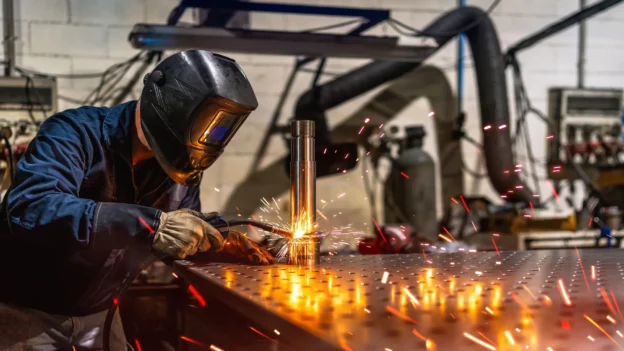I’ll admit it—when I first heard the word cadmizing, it didn’t really catch my attention. It sounded like one of those lab- based techniques that rarely make it to the field. But all it takes is one look at a threaded connection on a landing gear or a structural element exposed on an offshore platform to understand why this coating is still relevant—even in a world where environmental awareness is reshaping traditional methods. Today, I want to walk you through how this surface treatment, when applied and inspected properly on welds, becomes a true armor against corrosion.
Can cadmium be applied on welds?
Yes, and not only can it be done—in many cases, it should. Welds, as we know in the inspection world, are high-energy zones with complex microstructures and a natural vulnerability to corrosion, especially in coastal, industrial, or aerospace environments. The key is to understand that applying cadmium over a weld isn’t just about coating it— it’s about protecting it intelligently, with respect for its metallurgical properties and assurance that no surface defects will interfere with adhesion.
Standards like AMS-QQ-P-416 (formerly MIL-QQ-P-416) and ASTM B766 explicitly allow cadmium plating on welded surfaces, as long as strict process controls are in place. This is not a job for amateurs.
And while the aerospace industry has begun restricting cadmium in certain applications due to environmental and toxicity concerns, the truth is that in critical components— like aircraft fasteners or galvanized interfaces—it remains the gold standard. Why? Because it works, and when failure isn’t an option, cadmium is still trusted.
How is cadmium applied?
There are three main methods, and each has its strengths:
1. Electroplating (Galvanic Cadmizing): The most common and precise technique. A layer of cadmium is deposited using electric current in a chemical bath. Thickness is tightly controlled (typically 5 to 25 microns), and finishes may include clear or yellow chromates.
• Standard: AMS-QQ-P-416 Type I (as-plated), Type II (clear chromate), Type III (yellow chromate).
2. Diffusion Coating: The component is covered in cadmium powder and heat treated at 300°C to 450°C, allowing the cadmium to penetrate the metal surface. This is ideal for complex geometries like weld roots or inner fillet joints.
• Standard: ASTM A1059, ISO 9588.
3. Thermal Spraying: Less common, but used for large surfaces or field repairs. The cadmium is melted and sprayed onto the substrate with a thermal spray gun.
Regardless of the method, surface preparation is everything. You can’t apply cadmium on a weld that’s poorly cleaned or has slag residue. Abrasive blasting (with alumina or non- ferrous media), chemical degreasing, or even vibratory cleaning are essential. And in the case of welds, I always recommend pre-inspection using liquid penetrant (ASTM E165) or radiographic testing (ASTM E1742) to rule out any cracks or porosity before coating.
What do we inspect after cadmium application?
Once applied, the job isn’t over. Inspection is critical to ensuring long-term performance. I break it down into three essential stages:
1. Visual Inspection: First, observe. Look for uniformity, proper color, absence of flaking or uncovered areas. Good lighting and a trained eye go a long way.
2. Thickness Measurement: We use non-destructive methods like eddy current (ASTM B499) or magnetic pull-off techniques such as ASTM B530.
3. Adhesion Testing: A good coating is useless if it peels off. Cross-cut tape testing (ASTM D3359) or high- adhesion tape methods give us peace of mind.
For critical components—like fasteners for aircraft or subsea connectors—I recommend going further: salt spray testing (ASTM B117) or porosity analysis using electron microscopy can make the difference between a safe part and a vulnerable one.
So, what’s the point of cadmium coating on welds?
Welds aren’t innocent. Thermodynamically, they’re altered zones, often with microstructures ranging from austenite to martensite, depending on the material and welding process. And when you’re dealing with dissimilar metals (say, stainless steel to carbon steel), galvanic risk shoots up. That’s where cadmium steps in as a shield: it acts as a sacrificial anode, protecting the base metal even when the coating is slightly damaged. It also offers natural lubricity, which makes it great for threaded components, and moderate abrasion resistance, extending the life of bolts, studs, and other elements exposed to harsh conditions.
In my experience, cadmium coating isn’t just another surface treatment—it’s a silent ally in the battle against corrosion. When paired with good welding, proper surface prep, and rigorous inspection, it can extend a component’s life by years.
Is it worth it? Absolutely. Does it require technical knowledge and commitment? Without question. But those of us in the inspection world know that what we protect today prevents failures tomorrow. And cadmium, when done right, protects—and protects well.
This article was developed by Jorge Reyna specialist and published as part of the fifth edition of Inspenet Brief magazine August 2025, dedicated to technical content in the energy and industrial sector.

